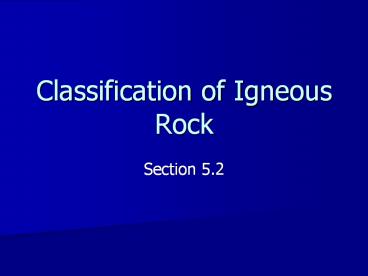Classification of Igneous Rock PowerPoint PPT Presentation
Title: Classification of Igneous Rock
1
Classification of Igneous Rock
- Section 5.2
2
Mineral Composition
- Intrusive
- Igneous intrusion
- Large crystals (macroscopic)
- Extrusive
- Lava flow or flood basalts
- Small crystals (requires magnification)
3
Mineral Composition
- Basaltic rocks
- Dark colored
- Lower silica content
- Contain mostly plagioclase and pyroxene
- Granite rocks
- Light colored
- High silica content
- Contain mostly quartz, K plagioclase feldspar
4
Mineral Compositions
- Intermediate rocks have a composition of minerals
between baslatic and granite rocks - Ultrabasic rocks
- Contain only iron-rich minerals
- Always dark
5
Texture
- Texture refers to the size, shape, and
distribution of the crystals or grains that make
up a rock - Rhyolite fine-grained
- Granite coarse-grained
- How is crystal size affected by cooling rate?
6
Texture
- Porphyritic texture large well formed crystals
surrounded by finer grained crystals of the same
or different mineral - Forms when slowly cooling magma suddenly cooled
rapidly - Vesicular texture spongy appearance Pumice is
an example
7
Thin Sections
- A slice of rock usually 2cm X 4 cm and only 0.03
mm thick - Light is able to pass through it
- A petrographic microscope is used to view thin
sections
8
Veins
- Valuable ores occur within igneous intrusions
Ores also occur in the rocks surrounding
intrusions called veins - Important metallic elements include gold, silver,
lead, and copper
9
Pegmatites
- Pegmatites veins of extremely large-grained
minerals - Lithium and Beryllium ores form in pegmatites
- Produce beautiful crystals
- Mount Rushmore in South Dakota
10
Kimberlites
- Kimberlites are ultrabasic rocks
- Form at depths of 150 to 300 km
- Named for Kimberly, South Africa
- Diamonds form in kimberlites
- Where in the US have kimberlites been found?
11
Construction Uses
- Interlocking grain textures make igneous rocks
strong - Resistant to weathering
- Granite is used in countertops, floors, and
statues
PowerShow.com is a leading presentation sharing website. It has millions of presentations already uploaded and available with 1,000s more being uploaded by its users every day. Whatever your area of interest, here you’ll be able to find and view presentations you’ll love and possibly download. And, best of all, it is completely free and easy to use.
You might even have a presentation you’d like to share with others. If so, just upload it to PowerShow.com. We’ll convert it to an HTML5 slideshow that includes all the media types you’ve already added: audio, video, music, pictures, animations and transition effects. Then you can share it with your target audience as well as PowerShow.com’s millions of monthly visitors. And, again, it’s all free.
About the Developers
PowerShow.com is brought to you by CrystalGraphics, the award-winning developer and market-leading publisher of rich-media enhancement products for presentations. Our product offerings include millions of PowerPoint templates, diagrams, animated 3D characters and more.

